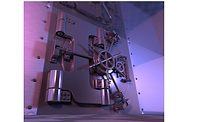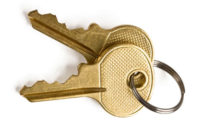The bottom line may be Wrangler Jeans.
Just as security and business applications are blending together through technology, asset tracking, especially in retail, is fitting into enterprises as snug as a pair of blue jeans.
Take, for example, Walmart Stores, the super-giant retailer headquartered in Bentonville, Ark. It has recently been assigned a patent developed by Bruce Wilkinson for “radio frequency identification tag sensors and methods” in the retailer’s continuing, pioneering effort to not only secure its supply chain from product to shelf but also to extend the technology to in-store inventory management.
The patent centers on tags and readers that can better handle both near- and far-field identification to cover products on the shelves, to better manage inventory in the store, to pallet and case tagging by product suppliers of Walmart. The technology and its application have myriad benefits, ranging from homeland security to theft to increasing sales by better handling products in stores.
Tags Get Smarter
Walmart continues to be at the leading edge of such efforts. For many years, it has worked with its suppliers to have them place smart tags on stock keeping units or SKUs as well as add to bill of materials as a component managed through materials requirements planning efforts. More recently, the retailer has extended RFID to in-store uses where sales associates, equipped with a hand reader, can determine if a pile of Wranglers lacks medium sizes with the wave of a wand.
For more years and mostly to combat shoplifting, retailers have used electronic article surveillance (EAS) systems, which is basically a technological method for preventing shoplifting from retail stores or pilferage of books from libraries. Special tags are fixed to merchandise or books. These tags are removed or deactivated when the item is bought or checked out. At the exits of the store or library, a detection system sounds an alarm or otherwise alerts staff or security when it senses active tags.
Two firms dominate EAS: Sensormatic of Tyco Retail Solutions and Checkpoint Systems. Both have, over the years, encouraged product manufacturers to build in their tags as they make their products. That’s called source tagging.
Both firms also have moved beyond loss prevention and into inventory management. The idea: Inventory accuracy, out-of-stocks, item location, price management, promotions execution, internal shrink and vendor fraud represent ongoing challenges that negatively impact retailer profitability. So security executives need to incorporate more intelligent and integrated technologies into their existing investment to help the enterprise to enhance the customer shopping experience and improve product availability while limiting shrink and lowering costs.
Radio frequency is one of several EAS approaches.
Beyond Security, Out-of-Stock Management
But more intelligent RFID solutions, which blend security and business needs as well as track and identify assets all along the supply chain, seem to hold more promise even in the face of its higher initial investment. For example, Proctor & Gamble, a major supplier to Walmart and other retailers, has suggested that it could increase annual sales by $1.2 billion thanks to RFID aimed at reducing incidents of out-of-stock items in stores.
Such a bottom line business return makes shoplifting losses look like small potatoes, especially for big potato retailers such as Walmart.
Still, some operations, smaller in size, often gravitate to solutions more specific to their challenges.
Chris Ryter, director of loss prevention and safety at Goodwill Industries of East Texas, knows his business and how to match problems to solutions. Goodwill Industries International, overall, is a significant retailer with annual sales of $2.59 billion, for instance. “When the stores are open, we receive many donations,” Ryter says. “Often when they are closed, donations are left off anyway. Security video indicated that people were also walking off with donations. By the time we could react to the video, those people were gone.”
So he installed a new IP audio system at three locations, with plans to grow to all 15 stores in his area of coverage. The solution is based on a centralized IP audio and control/monitoring solution, giving security officers a simple way to pull up a site on a laptop and initiate the local loudspeaker for a verbal warning if someone is seen stealing donations or causing vandalism.
“I did my homework relative to return on investment of the solution and it made sense from the get-go,” adds Ryter. The system has significantly cut down on theft, with a savings of $10,000 a week at each store through loss prevention via the audio solution. “There also is Power over Ethernet connectivity to simplify installation” and hold down the cost, says Ryter.
No doubt, when it comes to asset protection and tracking, different facilities have different needs.
Tracking TVs
Another case in point: the numerous televisions owned and used by the University of Kansas Athletics Department. The facility has people coming and going at regular and after hours. Brad Nachtigal, associate athletic director – facilities, operations & capital projects, had wireless asset protection devices attached to the TVs to guard against theft.
The technology attaches to any valuable requiring protection, including paintings, flat screens and other electronics, family heirlooms, safes, machinery, equipment and more.
“It’s an ideal solution for early warning notification or alarm verification,” says Nachtigal. The technology uses a micro-electro-mechanical system or MEMS accelerometer approach, which senses acceleration in the X and Y axes. When affixed to the protected asset, the device will trigger a “detect” if an attempt is made to move or disturb the asset. The device can be set to alarm to various seconds of movement or by degrees of tilt.
Other Sectors Sold on Asset Tracking
If it is good enough for Wrangler jeans, it is good enough for an expensive construction tool or a hospital cart.
Asset tracking can help businesses by:
• Reducing the loss of equipment and size of equipment inventory.
• Improving customer service by making it possible to locate the closest staff member when needed.
• Accelerating reaction time for an event needing a quick response.
• Enhancing patient care by helping staff quickly find the required device.
Among emerging solutions is the Cisco Context-Aware Mobility, which combines RFID and Wi-Fi tagging and provides business processes with information on the assets and resources in response to critical questions such as:
• Is it here?
• Where is it?
• What is its condition?
• What is his/her status?
• Where in my network is it?
This article was previously published in the print edition as "Tracking Assets for Security and Business Reasons."






